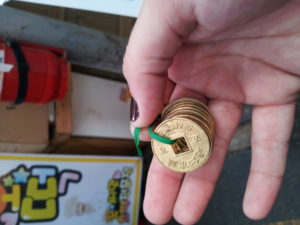
For this column, we cover the shopping districts and markets. There is plenty to see and buy in Seoul, and plenty of places to go strolling and window shop.
Tongin Market: take the Line 3 to Gyeongbokgung Station and you’ll find this small alleyway sandwiched between two modern business buildings, a remnant of the 1940s when the Japanese ruled Korea. Although some stalls have fruits, vegetables, and other groceries for sale, most are part of the lunch program put on by the Dosirak Café. Located in the middle of the alleyway, for ₩5,000 KRW ($4 USD/5$ CAD) you get an empty tray and ten brass coins. Simply go to a stall that is cooking food, and for one or two coins, you get a sample. And don’t worry, the portions are generous. After you fill your plate, head up to the café sitting area (utensils are provided here) to relax, eat, and experience new tastes.


Namdaemun Market: located outside the Hoehyeon Station (Line 4), this is a popular destination touted by travelers and locals as the premier place to buy, catering directly to tourists. However, most of the market consists of Western items and clothing that is overpriced. You can find most of the items at smaller markets for lesser prices, say ₩20,000 KRW ($17 USD/23$ CAD) instead of ₩100,000 KRW ($88 USD/119$ CAD). The quality and craftsmanship were also about the same. What sets Namdaemun apart is the sheer quantity of items available. As one of the largest markets, you can find just about anything here, from luggage to lingerie, but just watch the prices.

Seoul Gyeondong Market: this is a large whole-sale market that assaults the senses. Getting off the Line 1 at Jegi-dong Station, you immediately smell the herbs and spices saturating the air. Known for the largest collection of traditional medicines and cookware, the Gyeondong Market has everything you need to prepare a Korean meal. One of the sights you can visit is the Korean Traditional Medicine Experience Hall for Foreigners, where you can make soap and experience acupuncture, all for free supposedly. Unfortunately, I could not find an exact address for the Hall, and despite looking, it remained unfound. But even just wandering the market leads to interesting food and plenty of new smells and sights.
Insa-dong: located near the Buk Chon Hanock village, this is a good place to stroll and look at what Korea has to offer. The area right inside the entrance is mostly souvenir stands with tchotchkes, but further in you hit slightly upscale stores. In the heart of the Insa-Dong is Ssamziegil, a four-story mini-mall with cafés and artsy shops. If you walk along the many streets, you’ll find plenty of stores, stalls, tea houses, and restaurants with something to suit everyone’s interests.


Myeong-dong: unlike Insa-dong, although a popular place for tourists, Myeong-dong is more of an outdoor mall with department storefronts rather than stalls. These are mostly beauty and fashion stores, which cater mainly to Korean interests, and also sizes, so there’s not much to buy here. So while shopping is limited, the main draw for tourists is the street food. Possibly the largest collection of food stalls in Seoul, you can find everything here from Korean meatballs to fried squid to ice cream and waffles. You can spend a whole day here just eating, moving from stall to stall, sampling what Korea find delicious.
Noryangjin Fisheries Wholesale Market: located in the neighborhood of the same name, the Fish Market is a three story building filled with everything edible under the sea. If you didn’t know better, you might think it a strange aquarium, with live fish swimming laps in the tanks, or octopi slowly trying to crawl out of their buckets. The top-level has several restaurants where you bring in the fish you bought and they cook for you as requested. The price range is extensive, and you can haggle with some stall owners. Be warned, this is not the place to wear sandals or nice shoes; the floor is slick with an inch of water. If possible, wear boots. If you don’t want to brave the fish-sellers or restaurants, there are some outside stalls selling fried foods, about ₩10,000 KRW ($8 USD/$11 CAD). You can take the Line 1 or Line 9 to the Noryangjin Station and walk from there.


For more information, check out VisitKorea.



